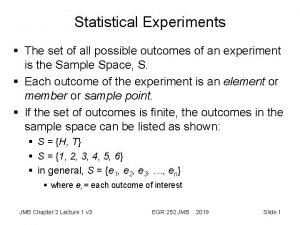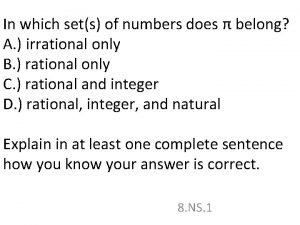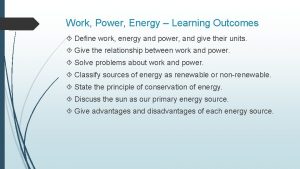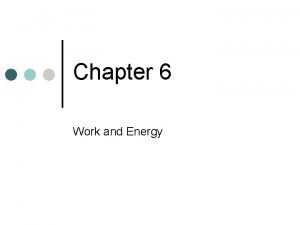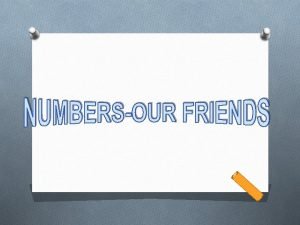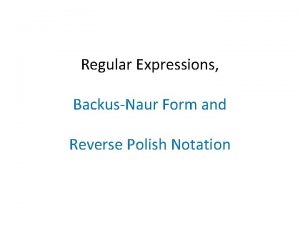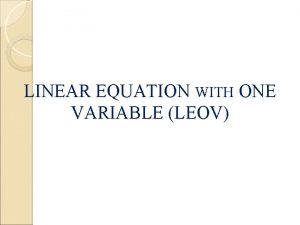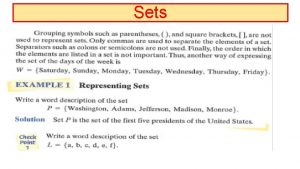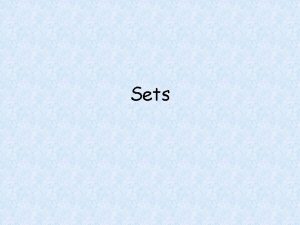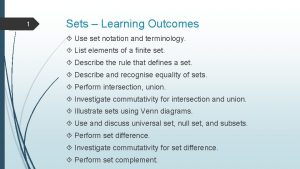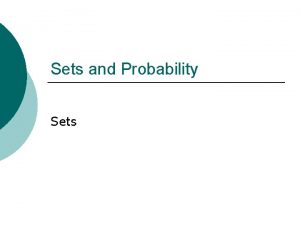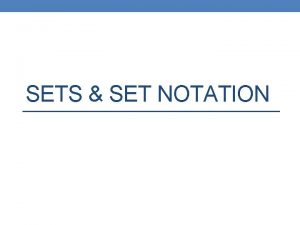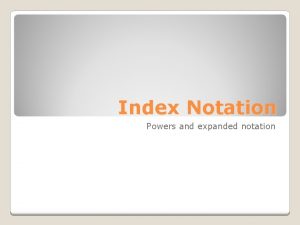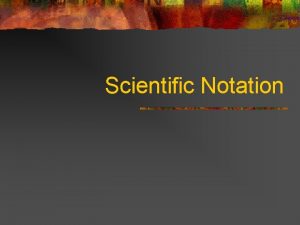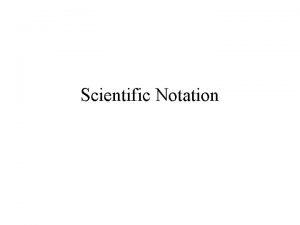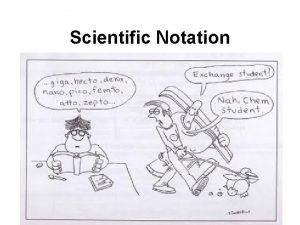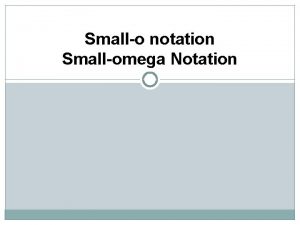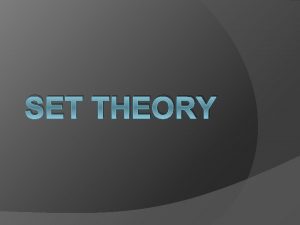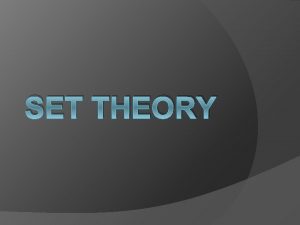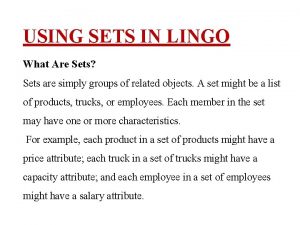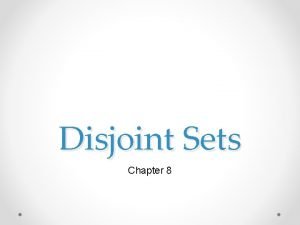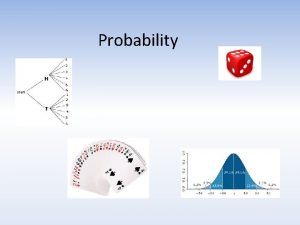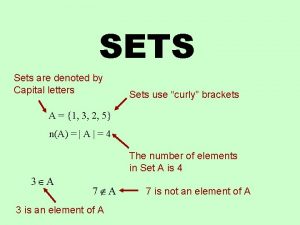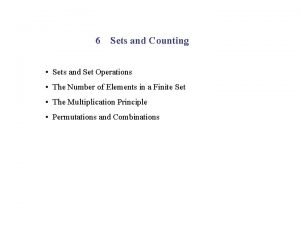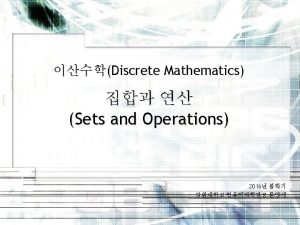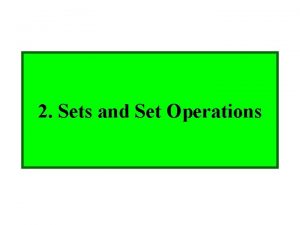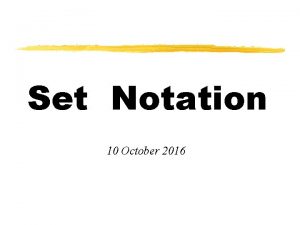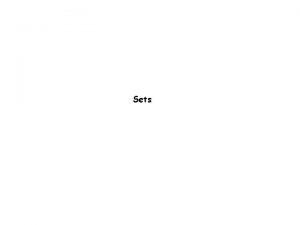1 Sets Learning Outcomes Use set notation and
























- Slides: 24

1 Sets – Learning Outcomes � Use set notation and terminology. � List elements of a finite set. � Describe the rule that defines a set. � Describe and recognise equality of sets. � Perform intersection, union. � Investigate commutativity for intersection and union. � Illustrate sets using Venn diagrams. � Use and discuss universal set, null set, and subsets.

2 Use Set Notation and Terminology � A set is a collection of objects, e. g. � furniture in a room, � players on a team, � students in this class, � numbers 1 -10. � Write down three more examples of sets. � Sets are usually labelled with a capital letter.

3 Use Set Notation and Terminology �

4 Use Set Notation and Terminology �

5 Use Set Notation and Terminology �

6 {} List Elements of a Finite Set � We write the elements of a set between a pair of curly brackets { }, e. g. � Furniture in my living room = {couch, armchair, table, dining chair, end table, lamp} � Irish rugby team = {Jamie Heaslip, Johnny Sexton, Rory Best, Andrew Trimble, … } � Students in Mr. Lawless’ maths class = {Fiona, Alanah, Abir, Sharmistha, …} � Numbers 1 -10 = {1, 2, 3, 4, 5, 6, 7, 8, 9, 10} � Write the elements of your three sets using proper notation.

7 {} List Elements of a Finite Set 1. If A is the set of odd numbers between 1 and 20, write the elements of A using set notation. 2. If B is the set of letters in the word Wicklow, write the elements of B using set notation. 3. Write the set of cities in Ireland. 4. Write the set of prime numbers less than 30.

8 # Use Set Notation and Terminology � The number of elements in a set is called the set’s cardinal number or cardinality. � The symbol # before a set means its cardinal number, e. g. � #furniture in my living room = 16, � #Irish rugby team = 33, � #students in Mr. Lawless’ maths class = 24, � #numbers 1 -10 = 10 � Write the cardinal number for each of your sets using proper notation.

# Use Set Notation and Terminology 1. Write down a set which has a cardinal number of 4. 2. Using your set of prime numbers less than 30, find the number of elements in that set. 3. If the box below is a set and its contents are elements, what is the cardinality of the box? by Stephan Kulla – public domain 9

10 Describe the Rule that Defines a Set � Give the rule that defines each of the following sets by describing their elements. 1. A = {1, 2, 3, 4, 5} 2. B = {9, 12, 15, 18} 3. C = {1, 4, 9, 16, 25} 4. D = {2, 3, 5, 7, 11, 13} 5. E = {k, l, n, y}. If the elements of E come from the word “Kilkenny”, describe the rule that picks these elements.

11 = Describe and Recognise Equality of Sets � Two sets are equal if they have exactly the same elements. � e. g. M = {banana, orange, apple} and N = {apple, banana, orange}. M = N. � e. g. A = {2, 4, 6, 8} and B = {8, 4, 6, 2}. A = B.

12 = Describe and Recognise Equality of Sets 1. A = {3, 6, 9} and B = {multiples of 3 less than 10}. Are A and B equal? 2. C = {3, 5, 15} and D = {factors of 15}. Are C and D equal? 3. R = {l, t, w} and S = {consonants in the word “trowel”}. Are R and S equal? 4. W = {vowels in the word “following”} and X = {vowels in the word “join”}. List the elements of A and B, and state whether or not they are equal.

13 Perform Intersection of Sets �

14 Perform Union of Sets �

15 Perform Intersection and Union 1. E = {4, 6, 9} and F = {4, 5}. Write the intersection and union of E and F using set notation. 2. M = {1, 2, 3, a, b, c} and N = {2, 4, 6, b, d, f}. Write the intersection and union of M and N using set notation. 3. Maths teachers = {Ms. Kerins, Mr. Coomey, Ms. Creegan, Mr. Lawless, Mr. Lynn, Ms. O’Shea, Ms. Coyle}. Science teachers = {Ms. Donovan, Mr. Lynn, Mr. Lawless, Ms. Coyle, Ms. Creegan}. Write the intersection and union for the sets of maths and science teachers using set notation.

16 Investigate Commutativity �

17 Illustrate Sets using Venn Diagrams � A Venn diagram is a picture that represents sets. � Venn diagrams have: � a circle for each set. � a label on each circle. � a dot for each element. � overlaps show intersection. � e. g. A = {1, 2, 3, 4}, B = {3, 4, 5, 6}

18 Illustrate Sets using Venn Diagrams 1. Draw a Venn diagram to represent C = {2, 4, 6, 8, 10} and D = {5, 6, 7, 8}. 2. Draw a Venn diagram to represent M = {a, b, c, d, e} and N = {a, e, i, o, u}. 3. Draw a Venn diagram to represent W = {1, 3, 5, 7, 9} and X = {2, 6, 10, 11}. 4. Draw a Venn diagram to represent Y = {even numbers less than 10} and Z = {prime numbers less than 10}.

19 Illustrate Sets using Venn Diagrams �

20 Illustrate Sets using Venn Diagrams � Some Venn diagrams do not show the elements of a set, instead showing the cardinality of each set. � e. g. the diagram below shows how many people in a survey like each type of chocolate. 1. How many people like both types of chocolate? 2. How many people like only one type of chocolate? 3. How many people like milk chocolate?

21 Use and Discuss Subsets �

22 Use and Discuss Subsets �

23 Use and Discuss Universal Sets �

24 Use and Discuss Universal Sets �
 Total set awareness set consideration set
Total set awareness set consideration set Training set validation set test set
Training set validation set test set A set of all possible outcomes.
A set of all possible outcomes. In which set does −173 belong?
In which set does −173 belong? Planning goals and learning outcomes
Planning goals and learning outcomes Reported speech objectives
Reported speech objectives Learning outcomes of input and output devices
Learning outcomes of input and output devices Sound energy definition
Sound energy definition Learning objectives of profit and loss
Learning objectives of profit and loss Learning outcomes of work and energy
Learning outcomes of work and energy Indian and international number system
Indian and international number system What is engineering notation
What is engineering notation Polish notation
Polish notation Infix to postfix conversion using stack
Infix to postfix conversion using stack Expected outcome example
Expected outcome example Learning outcomes of water cycle
Learning outcomes of water cycle Learning objectives for notice writing
Learning objectives for notice writing Swot analza
Swot analza Objectives of rhymes
Objectives of rhymes Photosynthesis takes place in the
Photosynthesis takes place in the Objectives of photosynthesis
Objectives of photosynthesis Ncbts learning outcomes
Ncbts learning outcomes Objectives of linear equations in one variable
Objectives of linear equations in one variable Learning outcomes generator
Learning outcomes generator Purpose of learning outcomes
Purpose of learning outcomes


